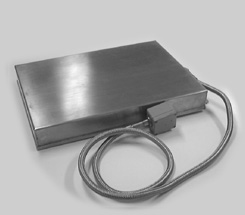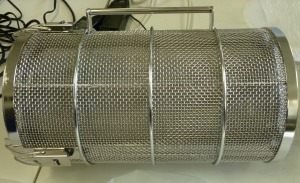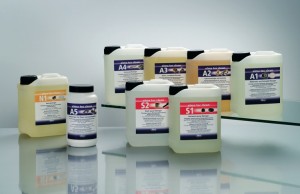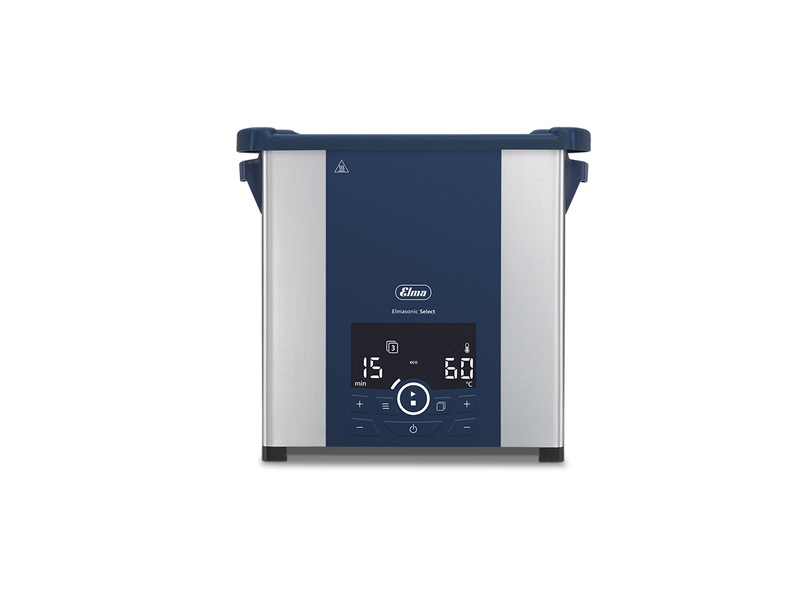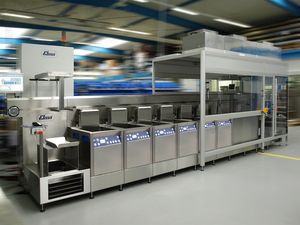Ultrasonic Cleaners
An Introduction to Ultrasonic Transducers
Most of our posts on ultrasonic cleaning describe the role of ultrasonic transducers in producing cavitation in the cleaning solution. We thought it would be a good idea to provide a short tutorial on ultrasonic transducer design configurations.
What Transducers do:
Ultrasonic transducers turn electrical energy into mechanical energy measured in thousands of cycles per second (kHz). Benchtop ultrasonic cleaners have transducers bonded to the outside of the bottom and/or sides of the cleaning tank and connected to the unit’s ultrasonic generator. Mechanical energy passes through the tank material – typically stainless steel – to create cavitation bubbles that do the cleaning. Here we’ll briefly describe the types available and variations on those types.
The Piezoelectric Transducer
The term is derived from the Greek piezo, meaning to squeeze or press and electron, standing for amber, which is ancient source of electrical charge. As described in Wikipedia, … Read the rest
Setting Ultrasonic Cleaner Power, Frequency and Time
In addition to using the correct temperature and cleaning solution formulation, achieving optimum results in an ultrasonic cleaning operation calls for a correct “blend” of ultrasonic power, ultrasonic frequency and cleaning time. Absent a proven recipe the three ingredients often are established through experimentation using ultrasonic cleaners that provide the flexibility to vary power, frequency and time.
Indeed, it may turn out that a fixed frequency and fixed power setting do not deliver the desired results. Adjustable power and adjustable frequencies may be the key to optimized cleaning action thereby reducing the time needed to complete jobs and improve operation efficiency.
A Brief Brief on Ultrasonic Power and Frequency
Power in this post is defined as the electrical energy in watts per gallon of cleaning solution delivered to the transducers that provide cavitation action in the cleaner. More power generally means faster cleaning but only to a point, beyond which … Read the rest
Sonic Cleaning Solves 3D Printing Mold Support Challenge
3D printing, also called fused deposition modeling and fused filament fabrication, has revolutionized and lowered the cost of traditional molding techniques such as the lost wax process. By using two moldable thermoplastic formulations such as ABS for the part itself and PLA for removable mold supports 3-D printing is capable of quickly producing highly complex configurations.
A key to the efficiency of the process is fast, safe removal of the PLA mold support without risking damage to the ABS part. An ultrasonic cleaner is proven far faster, safer and more effective than water sprays or manual scrubbing.
3-D Printing in Brief
Computer aided design files for components are programmed into the 3D printer which uses thermoplastic filaments to create components by successively building up extremely thin layers of plastic. The ABS filament ends up as the product; the PLA filament, deposited at the same time, serves as a support for … Read the rest
Tips on Mixing an Ultrasonic Cleaning Solution
Mixing an ultrasonic cleaning solution is simply a matter of following instructions. While it may be politically incorrect we refer to the common cliché “real men don’t read instructions” to introduce our point: There are many benefits to be gained by preparing an ultrasonic cleaning solution according to instructions.
Ultrasonic cleaning solution manufacturers such as Elma, represented by Tovatech, spend a significant amount of time developing instructions on preparing recommended dilutions and cleaning procedures for their line of liquid cleaning solution concentrates and powders. As an example, elma tec clean A4, a widely used demulsifying formulation for labs and workshops, is to be diluted to 2 to 5 percent with water in the ultrasonic bath. Whip out your calculator and figure out how many liters of cleaning solution can be prepared with a standard 2.5 liter container of biodegradable elma tec clean A4 concentrate.
Well golly, you might think (that … Read the rest
Two Approaches to Ultrasonic Degreasing
Ultrasonic cleaning is an excellent method to remove grease and other oily deposits on newly fabricated and refurbished metal parts. Two types of ultrasonic cleaning solutions – emulsifying and demulsifying (or non- emulsifying) – are commonly used for removing such deposits. Let’s look at these two options.
Emulsifying cleaning solutions collect oily contaminants in a mixture or an emulsion of the water-based cleaning solution and the oil. While cleaning is initially thorough continued operation of the cleaning bath causes a build-up of contaminants in the solution. This eventually reduces cleaning effectiveness.
Moreover, when products are removed from the bath they may carry this contamination into the rinsing cycle. Because of this carry out it is important that the parts are thoroughly rinsed to remove remaining emulsified oil. More than one rinsing cycle may be required.
Elma clean 210 is an example of an emulsifying cleaner that is a good choice … Read the rest
Mechanical Motion and Ultrasonic Cleaning Efficiency
Ultrasonic cleaners are used in applications as diverse as jewelry shops, hospital central service supply departments, auto repair shops and PCB repair. They are preferred over manual scrubbing with brushes and solvents because of their thorough cleaning action and ability to reach surfaces inaccessible by any other cleaning method. Biodegradable ultrasonic cleaning solutions are also more environmentally friendly than aerosol sprays and solvents.
The contaminant-removing power of ultrasonic cavitation – the implosion of millions of minute bubbles against surfaces being cleaned – can be substantially improved by introducing two mechanical means called oscillation (also known as agitation) and rotation to the cleaning cycle. We’ll look at these two techniques separately although in some equipment they can be combined.
What is Oscillation?
Our friends at Wikipedia define oscillation as “the repetitive variation, typically in time, of some measure about a central value (often a point of equilibrium) … Read the rest
Ultrasonic Cleaner Hints
You know the routine. Chances are you’ve done it yourself. If the recipe calls for a tablespoon of oregano you think well, two tablespoons will make it taste better. If directions say bake at 325⁰F you think well, if I bake at 425⁰F it will be done faster. That’s not the always the case for recipes and it certainly is not the case when you operate an ultrasonic cleaner.
How to Prepare Ultrasonic Cleaning Solution from Concentrate
This is the recipe portion of our introductory paragraph. Ultrasonic cleaning solution concentrates are formulated to be diluted with a specific amount of water. An example is the widely used general purpose elma tec A4 concentrate where the recommendation is dilution to 2% – 5% with water.
Now on the often mistaken theory of “more is better” you may be tempted to dump in a … Read the rest
How to Clean Inkjet Cartridges
Inkjet cartridges can represent a significant expense for businesses large and small. Investing in an ultrasonic cleaner system might prove practical to refurbish inkjet cartridges after which they can be refilled using widely available cartridge refill kits. Cleaning inkjet cartridges is fast, safe and thorough with ultrasonic cavitation produced in tabletop ultrasonic cleaners such as the Elmasonic Select series available from Tovatech.
The process is faster than soaking the cartridge print heads in a hot water and rubbing alcohol mixture then blotting them dry. The ultrasonic cleaning cycle can be as short as 3 to 5 seconds but may take longer if the cartridge jets are clogged with dried ink residues. When cleaning is handled properly it is safer than cleaning by hand because there’s no temptation to use brushes on the print head surface. It is thorough because cleaning action penetrates openings that cannot be reached by … Read the rest
Final Step Cleaning in Metal Fabricating
Product cleanliness is an important criterion for machine shops and metal fabricating shops producing parts meeting extremely tight tolerances. Removing all traces of cutting oils, dust, chips, turnings, polishing residues and other contaminants is necessary to ready newly fabricated and machined parts for shipping. Depending on the size of your facility an industrial or benchtop ultrasonic cleaner is your best solution to achieve optimum parts cleaning.
Ultrasonic cleaning is especially effective for fabricated or machined parts with intricate designs because the process acts on all surfaces immersed in specially formulated water-based biodegradable ultrasonic cleaning solutions. Hand scrubbing with brushes in solvent-filled wash tanks not only is time consuming; it cannot reach small crevices, blind holes and other tight spots or restricted areas. Moreover, solvent baths can be a health hazard and present disposal challenges.
How Ultrasonic Cleaners Work
Cleaning is accomplished by what is called cavitation. This is the implosion … Read the rest
Specifying Tips for Industrial Ultrasonic Cleaners
First of all, for the purpose of this post let’s define an industrial ultrasonic cleaner. Most simply they are floor mounted or wheel mounted when compared with tabletop ultrasonic cleaners. Basic ultrasonic cleaning technology is the same. The size of the parts being cleaned is high on the list of specification criteria, but also important are the steps employed to achieve the desired level of cleanliness. An example of where an industrial unit might be called for is our post on cleaning vehicle transmissions.
Cleaning Tank Size
Ultrasonic cleaning tank size is governed by the part or parts being cleaned. This also determines the amount of ultrasonic cleaning solution required to fill the tank – allowing for displacement due to parts being cleaned.
Tank size must take into account working depth to assure that parts being … Read the rest
